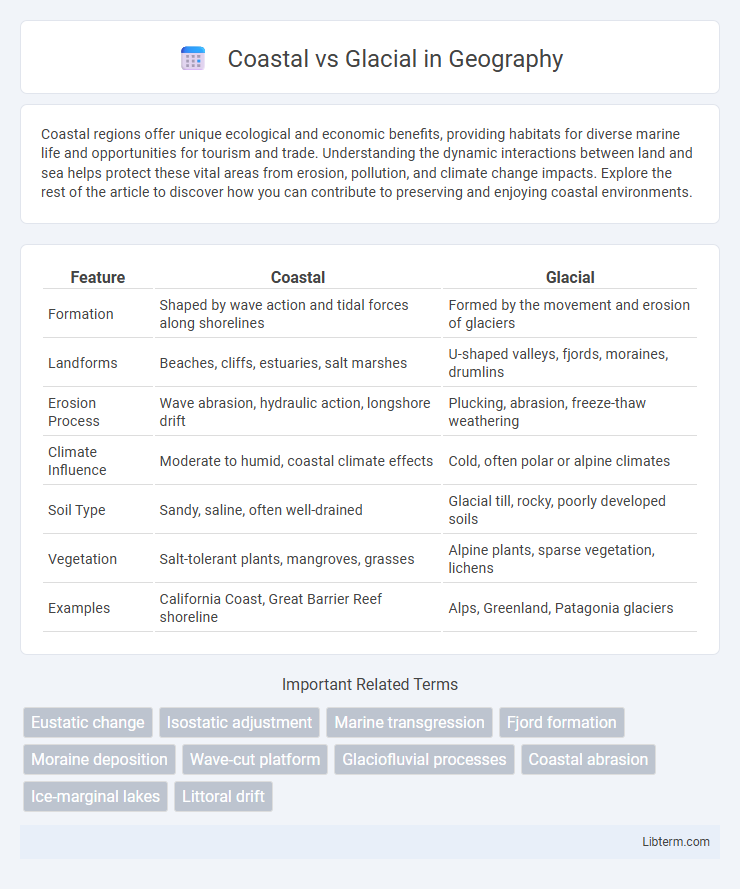Coastal regions offer unique ecological and economic benefits, providing habitats for diverse marine life and opportunities for tourism and trade. Understanding the dynamic interactions between land and sea helps protect these vital areas from erosion, pollution, and climate change impacts. Explore the rest of the article to discover how you can contribute to preserving and enjoying coastal environments.
Table of Comparison
| Feature | Coastal | Glacial |
|---|---|---|
| Formation | Shaped by wave action and tidal forces along shorelines | Formed by the movement and erosion of glaciers |
| Landforms | Beaches, cliffs, estuaries, salt marshes | U-shaped valleys, fjords, moraines, drumlins |
| Erosion Process | Wave abrasion, hydraulic action, longshore drift | Plucking, abrasion, freeze-thaw weathering |
| Climate Influence | Moderate to humid, coastal climate effects | Cold, often polar or alpine climates |
| Soil Type | Sandy, saline, often well-drained | Glacial till, rocky, poorly developed soils |
| Vegetation | Salt-tolerant plants, mangroves, grasses | Alpine plants, sparse vegetation, lichens |
| Examples | California Coast, Great Barrier Reef shoreline | Alps, Greenland, Patagonia glaciers |
Understanding Coastal and Glacial Landscapes
Coastal landscapes feature dynamic interactions between land and ocean, characterized by processes such as wave erosion, sediment deposition, and tidal fluctuations that shape beaches, cliffs, and estuaries. Glacial landscapes are primarily sculpted by the movement of ice, resulting in features like U-shaped valleys, moraines, and fjords formed through glacial erosion and deposition. Understanding the distinct geomorphological processes driving coastal and glacial landscapes aids in predicting environmental changes and managing natural resources effectively.
Formation Processes: Coastal vs Glacial Environments
Coastal formations develop primarily through wave action, tidal processes, and sediment deposition, shaping features like beaches, cliffs, and estuaries. Glacial formations arise from the movement of ice masses, which erode underlying rock, transport debris, and deposit moraines, drumlins, and fjords. The contrasting dynamics between saltwater-driven erosion and ice-driven sculpting create distinct landforms in coastal and glacial environments.
Key Features of Coastal Landforms
Coastal landforms are shaped primarily by wave action, tides, and sediment deposition, featuring key structures such as beaches, cliffs, spits, and estuaries. These landforms exhibit dynamic processes like erosion, transportation, and deposition driven by marine forces. Glacial landforms differ significantly, formed by ice movement and melting, resulting in features like moraines, drumlins, and fjords, distinct from the sedimentary and erosional patterns of coastal environments.
Distinctive Characteristics of Glacial Landforms
Glacial landforms are shaped primarily by the movement and melting of ice, creating distinctive features such as U-shaped valleys, moraines, drumlins, and eskers. These landforms exhibit sharp ridges, cirques, and fjords, formed through processes like plucking and abrasion. Unlike coastal landforms, which are influenced by wave action and tidal forces, glacial landscapes display evidence of past ice coverage and dynamic glacial erosion and deposition.
Erosion and Deposition Mechanisms
Coastal erosion primarily occurs through wave action, hydraulic pressure, and abrasion, which gradually wear away cliffs and shorelines, while deposition forms features like beaches and spits from accumulated sediments transported by longshore drift. Glacial erosion involves processes such as plucking and abrasion, where moving ice scrapes and extracts rock material, creating U-shaped valleys and fjords; deposition deposits moraines and drumlins as glaciers retreat. The key difference lies in the agents--water and sediment movement in coasts versus ice dynamics in glaciers--shaping distinct landforms through erosion and deposition mechanisms.
Biodiversity in Coastal versus Glacial Regions
Coastal regions support higher biodiversity due to nutrient-rich waters and diverse habitats like estuaries and mangroves, which provide breeding grounds for numerous marine species. Glacial regions exhibit lower biodiversity, with specialized organisms adapted to extreme cold and limited vegetation, including unique microbial life and cold-tolerant fauna such as polar bears and seals. The contrast in biodiversity between these areas is influenced by temperature, habitat complexity, and resource availability.
Human Impact on Coastal and Glacial Areas
Human impact on coastal areas intensifies through urban development, pollution, and overfishing, leading to habitat destruction, increased erosion, and declining biodiversity. In glacial regions, activities such as mining, tourism, and greenhouse gas emissions contribute to accelerated ice melt and disruption of fragile ecosystems. Climate change amplifies these impacts, threatening both coastal communities and glacial environments with rising sea levels and loss of freshwater resources.
Climate Change Effects: Coastlines vs Glacial Zones
Coastal regions experience rising sea levels and increased storm intensity due to climate change, leading to erosion, habitat loss, and saltwater intrusion into freshwater systems. Glacial zones face accelerated melting and retreat, contributing to reduced freshwater availability and altered downstream ecosystems. These contrasting impacts highlight the urgent need for adaptive strategies to protect vulnerable coastal and glacial environments under global warming.
Economic and Recreational Value Comparison
Coastal regions generate substantial economic value through industries such as tourism, fishing, and shipping, while glacial areas contribute via freshwater resources and hydroelectric power, supporting regional economies. Recreationally, coastal zones attract beachgoers, water sports enthusiasts, and marine wildlife observers, whereas glacial landscapes offer unique opportunities for skiing, mountaineering, and glacier hiking. Both environments sustain diverse job markets and recreational activities that boost local economies and enhance community well-being.
Conservation Challenges and Future Outlook
Coastal glaciers face conservation challenges due to rising sea levels and increasing ocean temperatures, accelerating melt rates and habitat loss for marine species. Glacial retreat in both coastal and inland regions disrupts freshwater availability and threatens biodiversity dependent on stable ice environments. Future outlooks emphasize the need for enhanced monitoring technologies and integrated climate policies to mitigate these impacts and support ecosystem resilience.
Coastal Infographic

 libterm.com
libterm.com